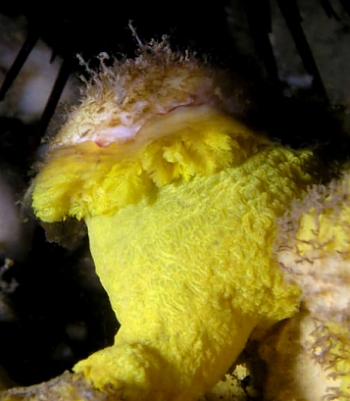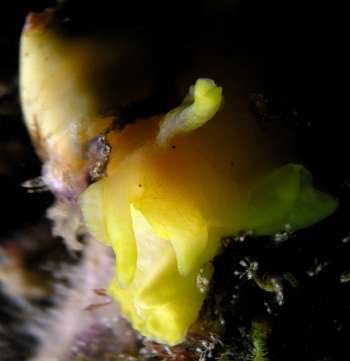Re: Tylodina fungina
June 1, 2006
From: Kevin Lee

Concerning message #16722:
Hi again, Doc...
Many thanks for the taxonomic lesson. Somehow, my brain erroneously had the Tylodina fungina categorized as a nudibranch, up till now. Accuracy is important!
In reviewing my Mushroom Sidegill images, I have only one (rear shot) that really shows the branchial plume, truly on the side and under the shell. Also, another foto, which shows distinct "eyes". Normally, the eyes are not so readily observable. Do they fade out or get covered up as the animal matures?
Locality: Shaw's Cove, Laguna Beach, approx 20 feet, California, USA, Eastern Pacific, Upper: 09 FEB 2005. Lower: 07 MAY 2005, rocky reef substrate . Length: both approx. 1.5 inches. Photographer: Kevin Lee.
Really enjoying your site. Keep up the great work.
Best regards,
K:-)
diverkevin@gmail.com
Kevin Lee, 2006 (Jun 1) Re: Tylodina fungina. [Message in] Sea Slug Forum. Australian Museum, Sydney. Available from http://www.seaslugforum.net/find/16755
Dear Kevin,
There's no extra charge for the taxonomic lesson - using 'nudibranch' as a general name is a common mistake in usage which just becomes confusing. Accuracy is important, not for its own sake, but because scientific names are more than a simple 'label' to attach to a species, they are a guide to the evolutionary history and relationships of the species. A bit like family names [surnames] in some human societies. For example all true nudibranchs are carnivores, so if we find a nudibranch-looking animal, such as Stiliger aureomarginatus, feeding on algae, then we can be pretty sure it is not a nudibranch and is most probably a sacoglossan. Scientific names give us clues to the biology and natural history. For example all species of Tylodina feed on sponges in the Order Verongida, Family Aplysinellidae, so if you find a species of Tylodina, even a new one, you can make a fairly confident prediction that it will feed on an Aplysinellid sponge.
Concerning the eyes, I suspect its a question of magnification. In larger animals, the eyes will be proportionally smaller in your photos so less easy to see. In Jim Lyle's message #14710 there is a close-up shot of the head of a 3 cm long animal and the eyes are quite visible, and certainly in the species I am more familiar with, Tylodina corticalis, the eyes are quite obvious even in a 5 cm long animal.
In your last message you mention a length of 3 inches, which is about 75 mm, much larger than the 30 mm length mentioned by Behrens & Hermosillo (2005). It's always possible you have found some very large animals so it would be nice to confirm the measurements if possible.
Best wishes,
Bill Rudman
Related messages
-
Re: Tylodina fungina
From: Kevin Lee, June 5, 2006 -
Tylodina fungina - variable shell shape
From: Kevin Lee, May 31, 2006 -
Re: Tylodina fungina from California
From: James Lyle, September 5, 2005 -
Tylodina fungina from California
From: Chris Grossman, July 29, 2005 -
Tylodina? from Monterey, CA
From: Clinton Bauder, July 18, 2005 -
Tylodina fungina from Shaw's Cove
From: Bruce Wight, January 30, 2002 -
Re: Tylodina fungina from California
From: Ron Velarde, February 5, 2001 -
Tylodina fungina food
From: Bruce Wight, February 5, 2001 -
Tylodina fungina from California
From: Bruce Wight, February 3, 2001
